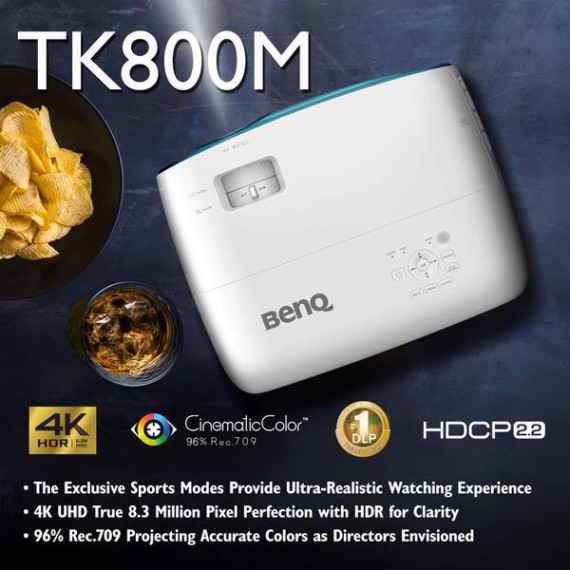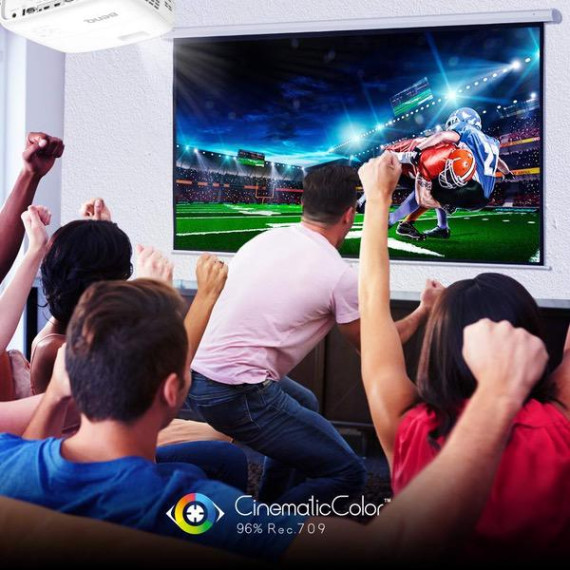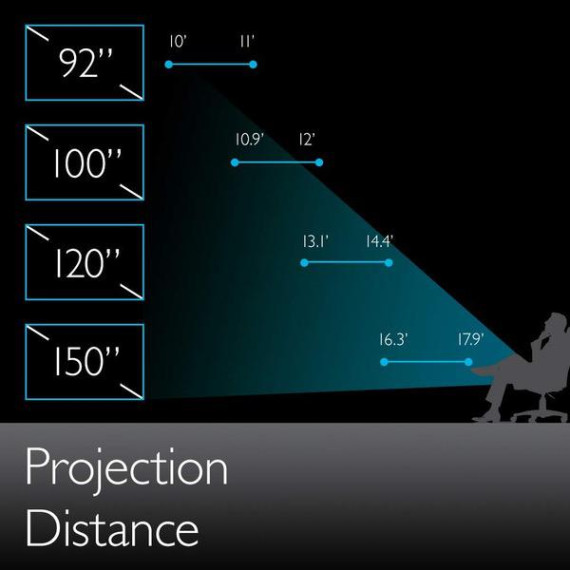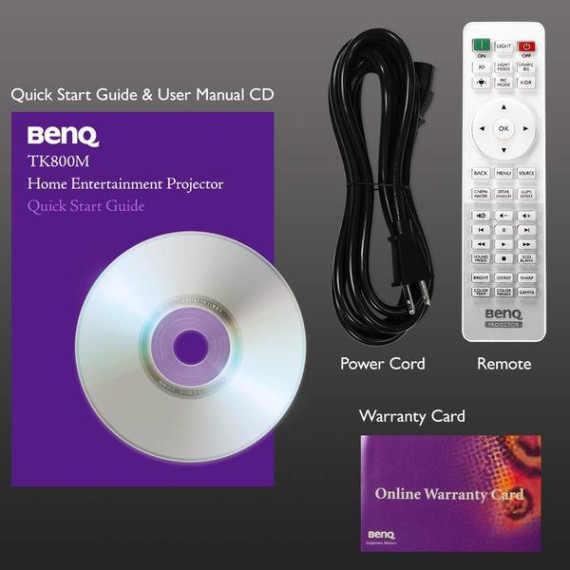Scott G.
I always set the stage of my reviews with a little context, so here we go... One year ago, I was able to review both the BenQ HT2550 and the BenQ TK800. They both represented a good 4K value into the still very young 4K projector market. BenQ was the first to announce consumer 4K projectors for less than $1,500. I enjoyed the TK800ʼs combination of brightness, color, and picture quality so much that I made it my primary projector in my large dedicated 160” screen home theater for over 8 months. I watch a lot of sports, movies, tv shows, and play a lot of video games. I use my theater for just about everything so a great ‘all rounderʼ projector with brightness chops and good color to boot is a must. The TK800 fit the bill with a few niggles, but overall, I highly recommended that projector to those in a similar situation as my own. This year, BenQ is positioning itself with several offerings in the affordable 4K projector space. I have recently reviewed the HT3550, a 2000 lumen 4K projector well suited for dark room viewing. I am very high on the HT3550 for what it does very well; 4K HDR with great color for the price. The HT3550 offers the first dynamic iris in a DLP in this price range, auto tone mapping HDR, better blacks, user upgradable firmware, and a shorter throw among other goodies. I am also currently reviewing the HT5550, the 3550ʼs older and more polished brother with a substantial black chassis, even better color coverage, contrast, and much much better placement flexibility. Then there is this TK800M, essentially a refined version of the TK800 from last year, that is being offered as the ‘valueʼ projector in their 4K lineup... AND ITS NO SLOUCH! The upgrades hit home for me. Before diving into the TK800M lets talk again about what the TK800 already did very well and how BenQ was positioning it last year. The TK800 was marketed for “Vivid Living Room Entertainment”. Itʼs higher brightness allowed it to cut through ambient light to make watching sports, playing games, or anything else people did in rooms with ambient light. The TK800 performed in this regard with aplomb. The reason I was so high on the TK800 is that it was able to do this and still offer a very good 92% Rec 709 color space coverage out of the box. So why the new model? Why the TK800M? BenQ is the first DLP manufacturer to implement TIʼs updated .47” DMD this year. The TK800M is among the first of these projectors to ship with this updated DMD which means NO LIGHT BORDER around this screen. Not only does this help with contrast (a bit) but also the level of immersion one can expect from their viewing. The other change made is an all new lens that promises better sharpness and contrast compared to last yearʼs model. This new lens is a 1.1x zoom instead of a 1.2x zoom, so there is a tradeoff of placement flexibility. More later. I have spent quite a bit of time with this projector. I left it up as my primary driver longer than expected because I enjoyed it so much. But letʼs get into my subjective impressions.... 4K Sharpness and Lens This projector achieves a “True 4K” (as defined by CTA) image of 8.3 millions on- screen pixel by shifting its native 1080p chip four times. This is known as XPR shifting. Let me just say that this little TK800M is the sharpest 4K projector I have seen. That is comparing it to the HT2550, TK800, Epson 4000, HT3550, HT5550, and Epson 5050UB (currently reviewing). And the sharpness is not anomalous to the unit. I have gone through two review units of this projector and both exhibit the same insane level of sharpness Iʼve yet to see on a projector. I can clearly see individual pixels. The focus knob has the widest range Iʼve seen in a small projector for the purpose of very easily making adjustments and finding that ‘just rightʼ focus. The new lens does an amazing job at creating a pixel perfect sharpness that really blew me away compared to the other six 4K projectors that have been through my theater. With that said, the lens does exhibit some minor chromatic aberration. On my 160” screen this is only noticeable at about 3 feet from the screen. My normal viewing was not affected by the aberration , however, so no harm no foul. HDR Compared to the TK800 unit I reviewed last year, BenQ has done a great job updating their future firmware releases with improved tone mapping for 4K HDR content. What I felt was very good HDR last year is improved upon this year. I also really like how a new mode called “HDR10” is engaged when HDR content is detected. This is nice to have your HDR specific HDR image settings are automatically called up. Projector manufacturers like Epson and Optoma can take a page out of BenQʼs book here. After being spoiled with how good HDR is on the HT3550 last month, coming back to TK800 made me realize even more just how good HDR is on the HT3550. When comparing the two, detail in shadows and highlights is much better handled by the HT3550 as is the overall brightness of the HDR image on the HT3550. The auto tone mapping does wonders on that projector and the TK800M just canʼt compete, although it does produce a really nice HDR picture. Where the TK800M CAN compete with HDR is in HDR gaming. Just like last year, the TK800M supports full 18gbps HDMI which means that it can handle the PS4/ Xbox One Xʼs full spec for 4K HDR gaming at 60 frames per second. So lets talk about gaming... GAME ON I have an Xbox One X and when choosing between the HT3550 and the TK800M, I choose the TK800M for gaming. 4K HDR gaming is simply amazing to play on. I play Halo Master Chief Collection and Forza Horizon 4 more than anything else and its hard to put into words how great it is in this regard. As far as 0.47” DMD 4K DLPs go, the TK800M has the fastest input lag among them all. I measured 42ms of input lag. This would be considered ‘good not greatʼ input lag. As a casual gamer, this is getting into the range of input lag that is hard for me to notice. The only other way to get lower input lag for 4K gaming in this price range is to go with the Epson 4010 for 33ms input lag. The tradeoff here is that the Epson costs $500 more (when on sale), only displays 4M on-screen pixels (some may not notice), and only supports 10gbps HDMI... so no 4K HDR @ 60 FPS. The Optoma HD27HDR (8ms 120hz/16ms 60hz input lag) is another gaming focused projector that can ‘acceptʼ a 4K signal, but only displays a 1080p image which kind of defeats the purpose of focusing on 4K gaming. All things said and done, I hope BenQ continues to focus on pushing the limits of image processing on their scaler/ shifter to bring their 4K projectorʼs input lag down even further. Two weeks ago, I had seven of my friends over for our monthly “Halo Night”. We always have a team of 4 on the projector in the theater and a team of 4 in the adjacent room with a 60” TV. I had two TK800M review units at the time and decided to put one in my theater, and the other TK800M projecting onto the wall in the other room instead of the usual TV. My friend, who is a discerning techie himself, said at least five times throughout the night, “What projector is this? This thing is amazing to game on.” The TK800M was a hit for game night. It offered a MUCH better gaming experience compared to the TV we usually play on for that room. The only drawback of the TK800M that some might find objectionable is the limited placement flexibility. I mentioned previously that the TK800M has an even smaller zoom than the TK800 which already was knocked for lack of lens shift. What this means is that to produce a 100” image, the closest the projector can be to the screen is 11 feet away with its 1.5-165 throw ratio. So you need to consider how big you want the image to be and if placing on a table, will that be in front of or behind viewers? BRIGHTNESS A strong suit of the TK800M, the projectorʼs brightness is its friend. You wouldnʼt put a clear slice in a dark-room projector, but for the TK800Mʼs intended purpose of being a high brightness projector for ambient light, the extra lumens are welcome from the optimized color wheel. I am able to watch sports, movies, game, and really do anything with the back half of my theater completely illuminated. This is great for sports viewing parties where I have food on the back bar and people coming and going. The other thing I love about the increased white brightness is that when there are white highlights on the screen, they REALLY pop. That could be a bad thing for some, but not for me. Its not overly distracting either. What that extra pop of brightness does is improve the perceived contrast to the human eye when content is on the screen. So lets talk about contrast performance... CONTRAST/BLACKS The extra white lumens really do their job improving the perceived contrast when there is content on the screen. The omission of the light border also helps perceived contrast relative to last yearʼs model. Where contrast struggles is in dark scenes since the black floor on this projector isnʼt exceptional. However, the intended audience for this projector is for high ambient light and living room use. In any living room or high ambient light environment, that ambient light hitting the screen negates any benefit from good performing contrast projectors. So for that reason, its hard to knock this projector since the contrast performance isnʼt bad for its intended audience. So at the end of the day, with the perceived improved contrast on bright scenes and lower contrast on dark scenes, its kind of a wash on contrast performance for the target audience. One thing to note on contrast, and perhaps something that BenQ can improve on in future designs is the lens ring assembly. They have already vastly improved the design for this yearʼs HT3550 which has virtually no light leakage off the front of the projector. However, the TK800Mʼs lens is recessed far back in a depressing that is lined with a reflective blue finish. This results in a fair amount of reflection, not from the lens or engine itself, but from the adjacent reflections in that lens depression itself. When this light is dispersed over a large area in an environment that is not light controlled, you will never notice it. But in a dark viewing setup, I would recommend lining that area with some black velour telescope flocking tape. Or projector screen tape. That completely eliminated light leakage/reflections on my unit, only serving to improve contrast further. 3D Canʼt do a review without getting into 3D performance. The 3D performance improves on the TK800. The image is very bright and seems to use its native lamp mode to illuminate such a bright image from the get-go. This results in a slightly green-tinge that can be adjusted/calibrated to get a more color accurate 3D image. It is bright though, Iʼll give you that. What has also improved on the TK800M is that you no longer have to manually engage 3D. 3D will automatically be detected and switched into 3D mode when content is played from a 3D Blu Ray. For personal libraries of 3D content, just make sure the source is displaying 1080p then play your side by side, top/bottom, or frame sequential 3D content, and then select the applicable 3D mode. I had no issue playing all of my 3D titles from my Plex library on my Nvidia Shield. COLOR As previously stated, color on this is really great considering it is a high brightness projector. Last year BenQ marketed the HT2550 as a color accurate projector intended for critical viewing. That projector was rated for 96% Rec 709 color coverage and had 2,200 lumens. The TK800M is rated at 96% Rec 709 and is rated at 3,000 lumens. This is an improvement from 92% coverage of the TK800 last year. So it certainly seems like it is eating its cake and having it too in relation to brightness and color accuracy. CONCLUSION People who know me already know Iʼve been high on the TK800. The TK800M makes that projector even better with the exception of its slightly worse placement flexibility. BenQ continues to build its TK line. As the second entry into the TK family, the TK800M represents a very good, albeit iterative upgrade over the TK800. While the removal of the light border will turn many heads, what stands out most about this projector relative to others Iʼve had the pleasure of review has to be incredible sharpness Iʼve observed. At $1,299, it represents a great value for its performance. This will be the projector I recommend to just about anyone interested in a projector for high ambient light or gaming setups! In classic ‘I like/Mehʼ fashion I like: -Really good combo of brightness/color -Best in class 8.3M pixel 4K input lag of 42ms -SHARPNESS! Sharpest 4K Iʼve seen. -No more light border -18 gbps HDMI -Great 4K HDR gaming projector -3D -Great for sports Meh: -Blacks/contrast in dark scenes -Light ring light reflections -Reduced zoom, placement flexibility
















